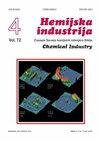纺织材料的输送性能和透气性
IF 0.8
4区 工程技术
Q4 ENGINEERING, CHEMICAL
引用次数: 0
摘要
通过纺织织物的传热和传质在实现人体最佳热舒适感知方面起着至关重要的作用。影响人体皮肤向环境传递热量和质量的纺织织物的控制特性是热传输能力、水蒸气渗透性和透气性。在身体活动或气候频繁变化的情况下,通过纺织品传递液体水分对热舒适很重要。尽管过去几年对纺织材料的输运特性进行了大量的研究,但在这一主题领域的研究仍然需要。本期特刊包括五篇文章,提供有关该主题的宝贵信息。商业和特殊设计的纺织结构都在研究中进行了调查,其雄心勃勃的目标是提供对其运输特性的新理解。在前四篇论文中,通过纺织材料的传热传质的某些方面在三个尺度上进行了分析:微观(纤维类型),中观(纱线几何形状和细度)和宏观(织物孔隙度)水平。第五部分研究了缝型和缝线细度对缝型结构输运性能的影响。本文章由计算机程序翻译,如有差异,请以英文原文为准。
Transport properties and permeability of textile materials
Heat and mass transfer through textile fabrics play a crucial role in achieving optimal thermal comfort perception by a person. The governing properties of textile fabrics by which they influence heat and mass transfer from the human skin to the environment are thermal transport capacity, water vapor permeability, and air permeability. The transfer of liquid moisture through textiles is important for thermal comfort during frequent changes in physical activity or climate. Despite numerous studies on the transport properties of textile materials over the past years, investigation in this subject area is still needed. This special issue includes five articles that offer valuable information on the subject. Both commercial and specially designed textile structures were investigated within the presented studies with the ambitious goal of providing a new understanding of their transport properties. Within the first four papers presented, certain aspects of heat and mass transfer through textile materials were analyzed at the three scale levels: microscopic (fiber type), mesoscopic (yarn geometry and fineness), and macroscopic (fabric porosity) levels. The fifth article dealt with the influence of the seam type and the sewing thread fineness on the transport properties of the seamed structure.
求助全文
通过发布文献求助,成功后即可免费获取论文全文。
去求助
来源期刊

Hemijska Industrija
工程技术-工程:化工
CiteScore
1.60
自引率
11.10%
发文量
12
审稿时长
6-12 weeks
期刊介绍:
The Journal Hemijska industrija (abbreviation Hem. Ind.) is publishing papers in the field of Chemical Engineering (Transport phenomena; Process Modeling, Simulation and Optimization; Thermodynamics; Separation Processes; Reactor Engineering; Electrochemical Engineering; Petrochemical Engineering), Biochemical Engineering (Bioreactors; Protein Engineering; Kinetics of Bioprocesses), Engineering of Materials (Polymers; Metal materials; Non-metal materials; Biomaterials), Environmental Engineeringand Applied Chemistry. The journal is published bimonthly by the Association of Chemical Engineers of Serbia (a member of EFCE - European Federation of Chemical Engineering). In addition to professional articles of importance to industry, scientific research papers are published, not only from our country but from all over the world. It also contains topics such as business news, science and technology news, information on new apparatus and equipment, and articles on environmental protection.
 求助内容:
求助内容: 应助结果提醒方式:
应助结果提醒方式:


